TL;DR Summary
This is a ridiculously long and verbose tutorial on Strava segments. The summary is that many standard segments suck, and that better versions often exist but are invisible to you unless you visit the web site version of Strava and inspect the “hidden efforts” list.
If you hide the sucky segments and unhide the good segments, you'll have a better Strava experience going forward, even when using the phone app. If enough folks do this, the experience improves for everyone.
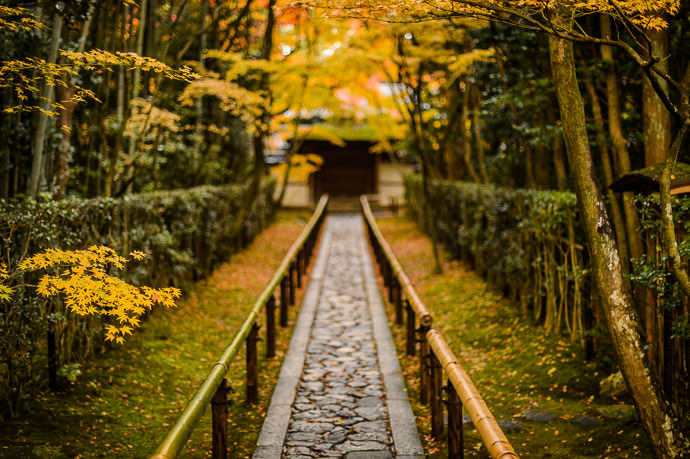
Nikon D4 + Nikkor 50mm f/1.4 — 1/160 sec, f/1.4, ISO 360 — map & image data — nearby photos
Koutouin Temple (高桐院), Kyoto Japan
Table of Contents
- Introduction
- What Are “Hidden” Segments?
- Why Would I Want to Hide or Unhide Specific Segments?
- Hiding Segments Manually
- Unhiding Segments Manually
- How To Promote a Good Segment in the Community
- Downsides to Manually Hiding or Unhiding Segments
- Okay, So What Makes a Segment Good or Bad?
- Inspecting a Segment on the Map
- Qualities of a Bad Segment...
- Undesirable Trait #1: Sloppy Starting Point
- Undesirable Trait #2: Sloppy Ending Point
- Undesirable Trait #3: Bad Road Tracking
- Undesirable Trait #4: Bad Summary Statistics
- Undesirable Trait #5: Stupid or Selfish Name
- Undesirable Trait #6: Unremarkable or Inconsequential Length of Road
- Undesirable Trait #7: Inappropriate for Strava's Matching Algorithms
- Conclusion
I enjoy reliving a bicycle ride by reviewing the statistics on Strava, seeing how well I did on certain stretches of road compared to how I've done before, or perhaps how I compare to my friends.
In the Strava universe, sections of road are broken up into “segments”, and if your ride traverses a segment, you'll get info about how you and others have done on it. If your ride transverses lots of segments, you'll get a lot of info.
Segments can be created by any Strava user at any time, which on one hand is really great and flexible, but sadly, many segments are poorly constructed. Whether through ignorance, sloppiness, or selfishness, many segments are bad, misleading, meaningless, and/or repetitious, and this can create a flood of data for a seemingly simple ride. This article is a tutorial on how to change the flood to a targeted stream of useful, interesting information.
As an example to illustrate the flood problem, consider this ride up a single road to the top of a mountain in Hawaii. It yields a staggering 62 segments:
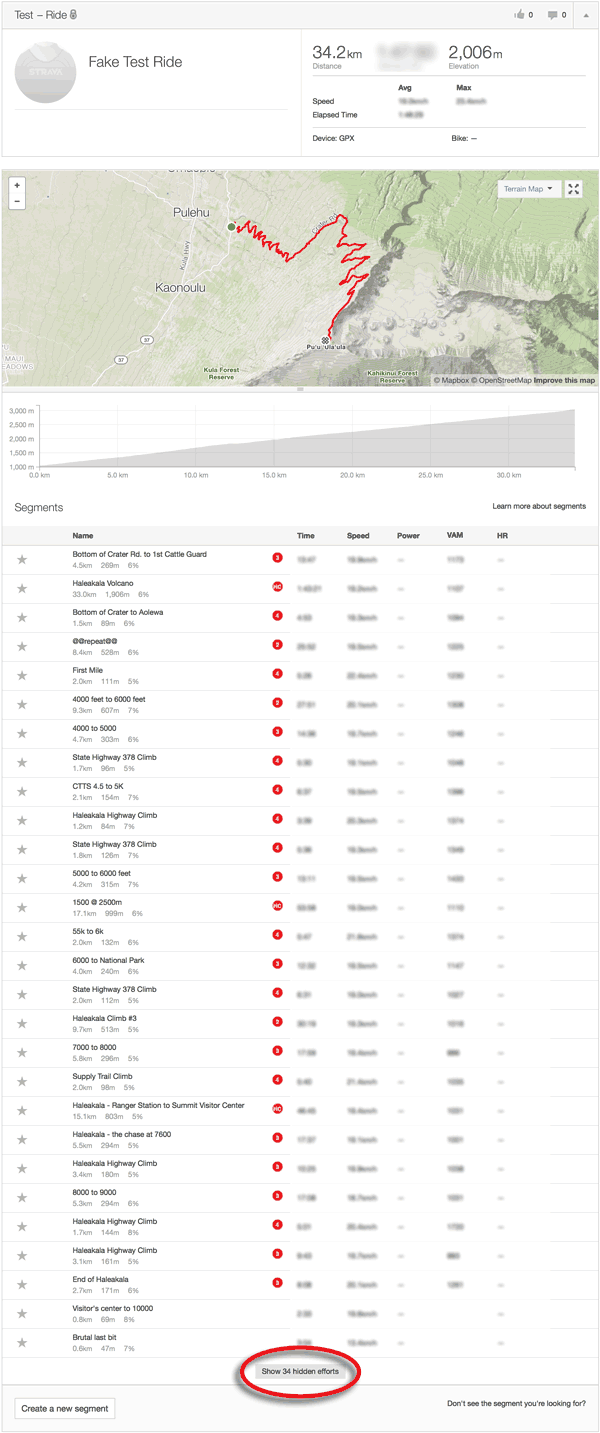
In this case, Strava at first displays only 28 segments, but clicking on the “Show 34 hidden efforts” button highlighted at the bottom of the list indeed brings up 34 additional segments:
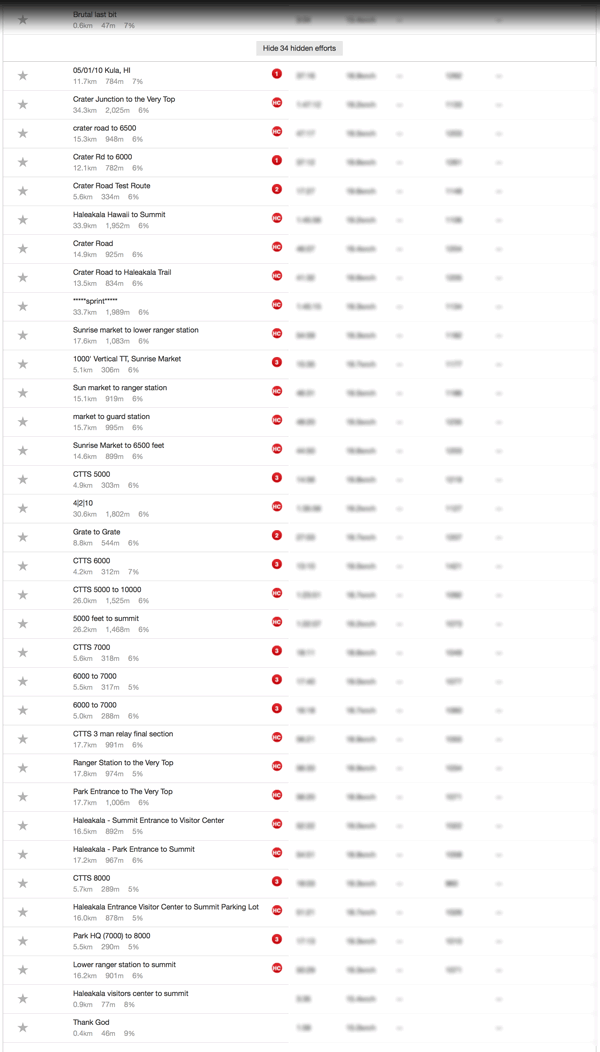
This is a fake, computer-generated ride created for the purposes of this blog post, and as such, the times and speeds are meaningless. It's a “private” activity on Strava under a test account so that the fake data does not pollute real Strava data.
The climb represented here is 34km (21mi) long, so I'm sure that there are interesting sub-sections that deserve specific segments, but 62 seems a bit excessive, so it brings up some questions:
- Why are there 62 segments for one climb?
- Why are some of them hidden by default, but others are not? What does “hidden” mean?
- Which segments are good and make sense?
- Why do four segments have the same name (“Haleakala Highway Climb”), and how am I supposed to know which ones to pay attention to?
There's a wide variety in quality among all those segments, so perhaps most importantly this brings up the question “How, as a member of the Strava community, can I help raise the quality of segments we all see?”
This last question is the whole reason I've written this tutorial, to help members of the community raise the quality for everyone. Strava provides only a few tools to allow users to rate segments, and though these tools are poorly designed and mostly ineffectual, perhaps if enough folks use them we'll see more high-quality segments and less bad ones.
Strava generally hides some segments, with a stated goal of reducing clutter. Sadly, I think that Strava policies actually encourage the popularity of poorly-constructed segments (more on this later), so it behooves the Strava rider to look through all the segments to sort out the good from the bad, at least if it's an area that you ride often. As we'll see in a bit, you can manually hide bad or uninteresting segments, and manually “unhide” good segments: going forward, these choices are carried through your entire Strava experience (both on the web site and phone app), so the up-front work to choose segments pays off over the long run.
Users of the Strava website who notice the “show hidden efforts” button have the option to see all segments, as we did above. The Strava phone apps, though, give no indication about hidden segments, and since these apps are how the majority of Strava users interact with Strava, most users have no idea that hidden segments even exist. If you're a phone-app user, you have to visit the Strava website to play along with this post. It's worth the effort, though, because improvements you make via the web site are reflected when you visit via the app.
Why Would I Want to Hide or Unhide Specific Segments?
The obvious answer is that you want to see only high-quality segments that are interesting and meaningful to you, but there are community-wide benefits as well, which we'll certainly cover later. But before we look at that, and at the factors that go into making a segment “good” or “bad” in the first place, let's first look at the mechanics of manually hiding and unhiding segments....
Strava automatically hides or shows some segments. With the phone app you have no indication that some segments are hidden, nor control over the segments you see. On the website, however, they let you explicitly override their choice and hide or unhide segments as you like. You need to do this only one time per segment, because once you explicitly tell Strava to hide or unhide a segment, your choice is remembered throughout your entire Strava universe, both on the web site and in the Strava phone apps.
Hiding a segment is simple: when you mouse over a segment in the list of activity efforts, a “Hide” button appears, as illustrated here:

Clicking the “Hide” button, of course, sends the segment to the list of hidden segments, and tells Strava that from now on when viewing any activity from anybody, you'd prefer not to see that segment. This preference is carried over to the phone-app view, so if you're a Strava phone user, you can occasionally visit the web site to clean clutter for your phone-app view.
If you hide a segment that you rode multiple times in the same activity (such as if you rode loops or repeats), clicking the “Hide” button actually removes only the one row from this list, but when you reload the activity (just do a refresh it in your browser), all the efforts on that segment will then be properly hidden.
Note that if you actually click on the segment row, Strava opens up the segment list and inserts a mini summary of the clicked-on segment, with a little map and info about your effort on it. In this case there is no “Hide” button, so click again on the segment row to close up the summary and reveal the “Hide” button.
Unhiding a segment is comparable to hiding one:
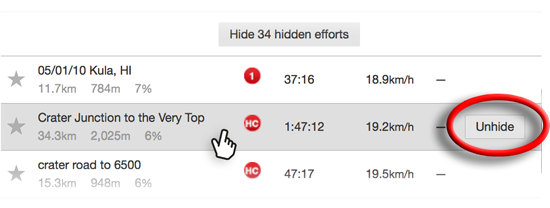
When you unhide a segment, it immediately returns to the unhidden segments at the end of list, rather than in the proper chronological place in the list. Just reload the page, and it'll show in its proper position.
A newly-unhid segment that deserves an achievement badge (a badge for a PR, KOM, QOM, or the like) won't get one, because Strava computes and assigns the badges only to visible segments, and only when the activity is first loaded, or when you explicitly ask for the badges to be recomputed.
If you're working with your most recent activity and have just hid or unhid segments, you can have Strava recompute the badges by clicking on the “wrench” icon and choosing “Refresh Activity Achievements”:
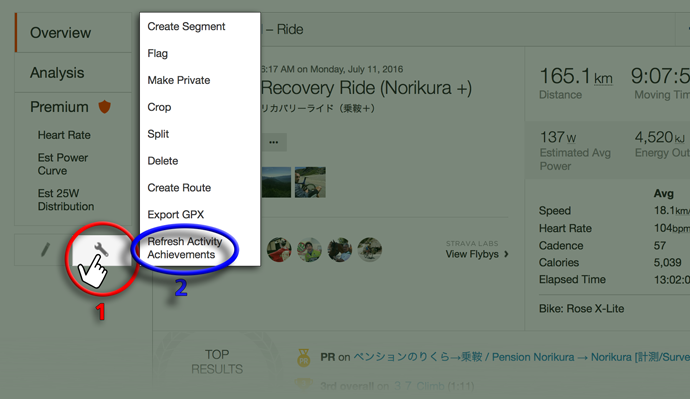
You'll have to reload the page to actually see the new badges.
Warning: due to how Strava has implemented “Refresh Activity Achievements”, I don't recommend using it with anything but your most-recent activity. You'd think that when “Refresh Activity Achievements” is done on an old activity, Strava would consider only efforts up to the point of that activity so that, for example, what was a PR or a KOM at the time remains a PR or a KOM for the effort. But no, they consider subsequent efforts as well, meaning that you'll lose a badge for what had been a KOM/QOM/PR at the time if it was bested any time later.
I imagine that Strava has taken this approach because it's likely substantially less resource-intensive, so I understand it, but it's still a bummer.
How To Promote a Good Segment in the Community
When a new segment is created, it is either hidden for everyone or visible for everyone. If it's the first segment in an area, it'll likely be visible to everyone right away, but if it seems to be a repeat of something already there, it'll be hidden from everyone, and will stay hidden until folks manually look for it and unhide it.
If enough folks eventually do unhide a segment, it has the chance to be promoted by Strava to not being hidden by default. Also, the more users that “star” a segment (mark it as a personal favorite), the more likely that the segment will become unhidden by default.

This approach may sound nice on paper, but in the real world it's pretty bad. The only reason to create a segment that covers the same stretch of road as one already there is because the one already there sucks for some reason or another. (Again, we'll go over characteristics that make a segment suck later.)
Consider these segments for the same steep climb in Kyoto; one segment isn't particularly good, but it's entrenched because it was created long ago; the other segment is one that I created earlier today:
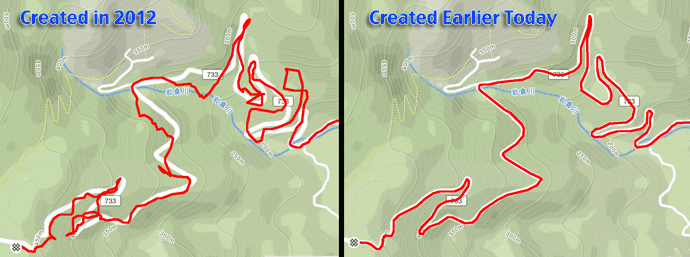
The segment I made is better in every respect than the original, except that the better one will be hidden from every Strava user that doesn't go looking for it and unhide it.
(It'll remain hidden by default until — if it ever happens — enough folks unhide it and Strava decides to promotes the better segment to “unhidden” by default.)
Downsides to Manually Hiding or Unhiding Segments
The only negative side effect that I have run into of clearing out crappy segments and promoting good segments relates to friends who have not done this. They still see their own view of segments, which usually means that they see Strava's default list of (often bad) segments. This also means that they'll see achievements (PRs and the like) for segments you've hidden, and they'll not see achievements for segments that you had unhidden.
This can sometimes create confusion, such as when they compliment you on a PR for such-and-such a climb, when you know you didn't PR that climb. It turns out, for example, that they're looking at a poorly-designed segment that you had hidden because if includes the common place to rest after the end of the climb, so your post-climb rest is included in the total effort time. That makes the segment meaningless, so you hid it, but they don't know that, and because today you happened to not pause as long as you did on earlier attempts, you made a “PR” on that segment.
Or it works the other way as well... you did PR the climb, and this is reflected in the high-quality segment that you unhid, but the low-quality segment that includes the post-climb rest shows a much longer, non-PR time.
It also impacts the achievement badges that you see on others' rides. An acquaintance recently did hill repeats, and when I view his activity I see no badges, so it appears as if he wasn't even fast enough on any of them for a “3rd-best personal effort” badge:
The thing is, his first 3:16 effort on “Mochikoshi Pass West” was a PR (by 28 seconds!), and his second effort, just two seconds slower, should have earned a “2nd-best personal effort” badge. The badges are missing because these super-high-quality segments (with ugly names) are, like for everyone who doesn't manually unhide them, hidden from him, so Strava doesn't bother computing the badges. Heck, even if he had gotten a KOM, it wouldn't have been highlighted.
So this adds one more reason to the list of why a segment effort has no achievement badge:
You've ridden the segment at least four times, and this time isn't among the top three.
It's your first time to ride a segment, and you didn't place in the all-time top 10 for your gender.
The segment was hidden for the rider when achievements were computed (when the activity was uploaded, or when “Refresh Activity Achievements” was invoked).
I think only the first is valid reason to not show an achievement.
As an aside about that second reason, I wish Strava would give you a “first time!” badge when you first ride a road, both to celebrate your expanding world and to communicate that fact to friends. As it is now, a ride in a new area creates an activity without achievement badges, making it look like it was just a slow, boring outing not worthy of a closer look, when in reality you might have been really killing it, but just on a road you'd not ridden before. Sigh, if only I were King of Strava, I'd fix all these problems.
Anyway these “downside” problems should subside over time, as you enlighten your friends and they, too, clear out bad segments and promote good ones.
Okay, So What Makes a Segment Good or Bad?
This can be a loaded question because personal preference can play a large part in some of these considerations, but a bad segment in my eyes suffers from one or more of the following:
- A stupid or sloppy starting point
- A stupid or sloppy ending point
- Bad road tracking
- Incorrect summary data, particularly slope and elevation data
- A stupid or selfish name
- An unremarkable or inconsequential segment of road
- A section of road inappropriate for Strava's matching algorithms
We'll soon spend the rest of this article looking at examples of each of these, but first, in order to judge the first three items we need to know how to inspect a segment's course on a map, so let's look at that...
Inspecting a Segment on the Map
Several ways listed above on how to judge a segment involve looking at it on a map, and with Strava there are two different “segment route” views, and they're both important: one is how your particular route matched to a segment this time, and the other is the original rider's route used as the basis for the segment (and so it's used as the basis to which all activities either match or don't match, and if they do, how they match).
It's important to understand the difference between these two, and how to inspect each.
Here's a bird's-eye view of our test activity, showing a sequence of events:
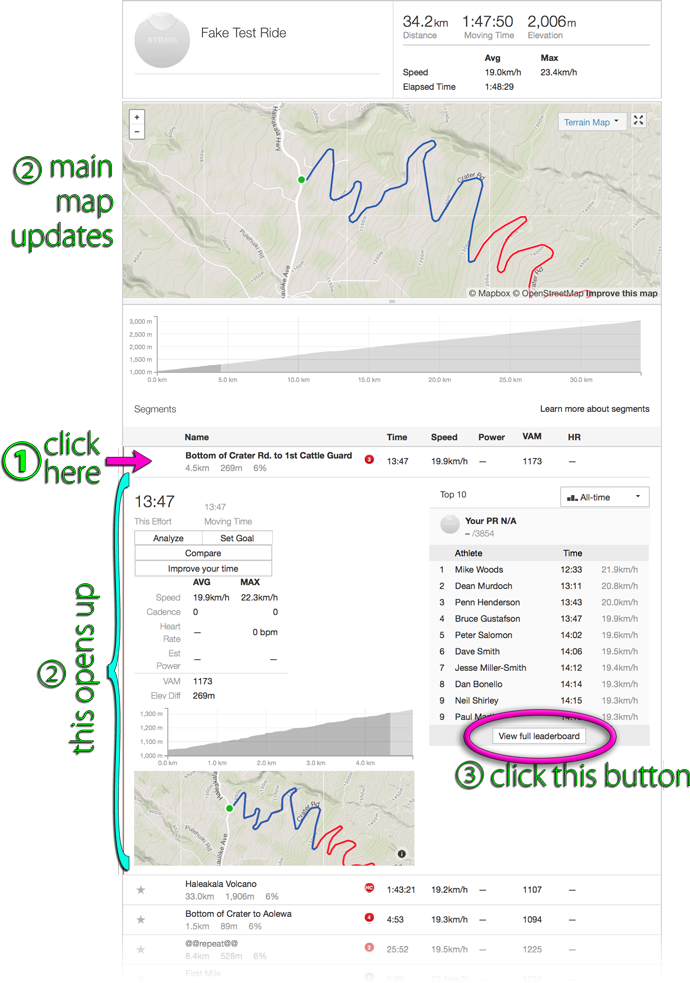
Clicking on the row for a segment opens up a lot of detail about the segment, including a mini map and leaderboards on the right. (Which leaderboards show up is a preference item that you can configure in your Strava account settings.)
At the same time that the segment detail opens up, the main interactive map at the top of the activity focuses on the segment. Both maps show your activity, with sections of your track that match the segment presented in blue.
The other map view for a segment is seen on the segment's home page. Clicking on the “View full leaderboard” button (item #3 in the screenshot) brings you to the segment's home page, and the route shown on the map there is the “master route” for the segment. It's the route used by the user who created the segment, and has the master starting and ending points.
Okay, so now that we know how to inspect a segment's route, let's look at how to judge its quality...
Qualities of a Bad Segment....
The remainder of this article goes over characteristics that make a segment bad....
Undesirable Trait #1: Sloppy Starting Point
This is perhaps the most common thing that makes a segment bad... a poorly-thought-out starting point.
Consider this simple example from above:
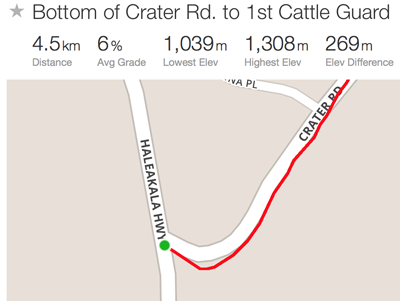
At first glance the starting point right at the intersection perhaps looks reasonable, but there are two problems with this.
The first problem is that if you stop at the intersection prior to starting the climb — such as to wait for friends to catch up before the turn, or simply to prepare for the epic climb you're about to embark upon — this segment's start point at the interesection includes that stopped time in your overall effort, making the segment completely meaningless.
This is enough to render the segment junk in my book, without even needing to look at anything else. I would absolutely hide this segment.
For the second problem, let's look at that intersection in real life, via Google's wonderful Streetview:
This view is from the north looking south. We've got the north-south road running along the right edge of the screen, with Crater Road (the big climb) starting off to the left.
I've marked about where the segment begins and the path it then embarks upon. Clearly, the person who made this segment had ridden down the road from the north, from behind the camera's view in the screenshot above. That's fine, but what about folks who approach the road from the south, from the upper right in the screenshot above?
Here's the view when approaching from the other side:
These folks will naturally peel off to the right, rather than continue north and take the sharp turn meant for the opposite direction. Do we want this segment to match these folks' ride? If so, will it? If it will, from where?
The first question (“do we want it to match people riding from the south?”) is for the person who created the segment, but with a name like “Bottom of Crater Rd. to 1st Cattle Guard” it's safe to assume they didn't intend to exclude these folks.
Whether it actually will or won't match someone's ride is up to how accurate their GPS units are, and the details of Strava's matching algorithms. I'd think that it generally would match, but from exactly where? Can you trust an effort time when you don't even know what it covers?
Rather than have to wonder about these questions, it's smarter to have the segment start slightly after the intersection, both to accept folks riding in from either direction, and to avoid including such a natural stopping point within the segment. Here's a segment with a starting point that avoids these problems:
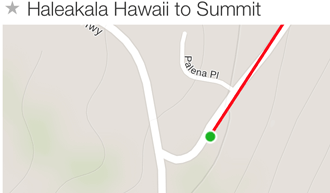
I would unhide this segment, and hide the first.
There are many, many examples of this around the Stravaverse. I ran into a funny one while working on this article, a segment in the Netherlands named “Tienboerenweg” with a horrible starting point on the wrong side of what looks to be a big intersection:
So what's funny is that a year later, someone created a “Tienboerenweg (fixed)” segment. With “fixed” in the title, you'd think, you know, that the problem was fixed, but no, it's just as bad as the first:
Sigh. If I rode in the area, I would hide both.
Another kind of unfortunate starting point is one that doesn't make sense to the specifics of the road or the climb, though this can certainly be a matter of personal preference.
An example from an area I'm familiar with in Kyoto is a segment that begins this way:
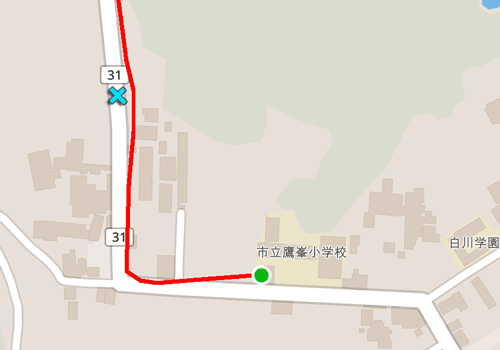
If you're familiar with the area, the choice of this starting point is puzzling, to say the least. The east-west road it starts on is essentially flat, with nothing particular at all at the place the segment starts. As the road continues and turns north, there are natural places to stop and join up with others (like this), and then the road starts to slowly climb as you leave city. After a short bit you pass the last buildings and enter the forest where the climb starts in earnest, so I'd think a segment for this climb should start about there, where the blue “X ” is.
There could well be some common benefit to this starting point that I'm just not seeing, but as it is it simply makes no sense to me at all. (Lots about this segment makes no sense to me, as we'll see later.)
Local Considerations for a Good Starting Point
Sometimes it's a balance among conflicting goals. For example, the pair of segments featured in “Tale of Two Segments” above have slightly different starting points:
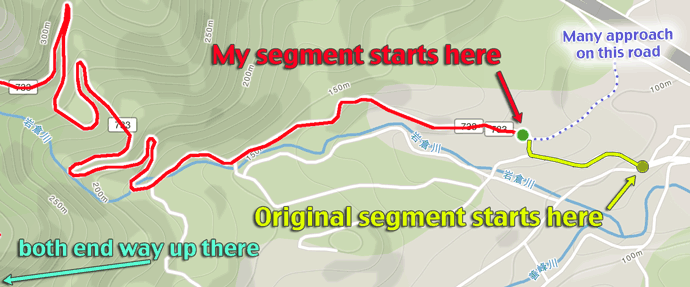
I chose to start this segment about 280m (about 0.17mi) farther in than the original, just after a 90° bend in the road that seems to me to be a natural starting point for the climb. More importantly is that the slightly later start allows the segment to match folks riding to the climb via the road coming in from the northeast (riding in on the blue-dotted road in the screenshot above).
At the moment, my carefully-crafted segment matches 585 rides, while the original matches only 413. Some of that difference is certainly due to the accurate road tracking in my new segment, but I'm sure most comes from including folks who took the north-eastern approach.
A possible detriment to my segment is that in skipping that initial bit of road, I lopped 20m (66') of elevation. How intrinsic that little bit is to the climb's overall character is a matter of personal opinion. Overall it's a brutal climb with some sections above 20%, so the bit omitted at the start doesn't seem particularly material to me, but YMMV.
Along those lines, the original segment itself could have made a bigger climb by starting even farther down the increasingly-gentle slope of land. At some point you back up enough that you've hit the ocean and can't start any lower, and only then can this argument be truly put to rest.
Going the other way, in looking at another great resource for segment design, Strava's Global Heat Map, there is perhaps a need for a much-truncated starting point:
The heatmap indicates a third approach, just south of the main approach, not serviced by either segment. In a ride heatmap, the road glows more brightly the more times it's been ridden, so based on that this new southern approach seems to be only a bit less popular than the approach my update allowed for. Perhaps we should not exclude these folks, moving the starting point to the red “★” in the screenshot. Or perhaps the lead-up that would be cut out by such a change is sufficiently important that we need a totally new segment, starting at the yellow “★” mark?
It turns out that there's a conspicuous landmark just past the red “★”, a tiny bridge where the road jinks sharply. When I ride across that bridge, I feel a sense of “okay, here we go!” impending doom... the climb is about to get real. So, with such a clear demarcation point, perhaps it's a good place for a sub-segment to start, so I made one, and now I've started to rethink whether this should just be the main climb. Compared with the other one I made this cuts off an 800m span that averages just 5%, which causes the overall average to rise from 8.3% to 8.9%, more accurately representing the pain of this climb.
But now that I've created the segment, I see that it matches 582 rides, just three short of the first segment I made. I expected more based on the heatmap, so I guess it's difficult to differentiate based upon brightness. A single ride is readily apparent in the heatmap, as are highly-popular roads, but there's a lot of numerical variation in the in-between zones that are not apparent visually. Or so it seems. It's a great resource, but I'm still learning how to read it.
Choosing the “proper” start to “the” climb is not something done with a map, but by getting a feel on the ground and, often, by community consensus. Even then, rational minds can disagree, and so perhaps there really is a need for two or three or more separate segments for this climb. Time will tell.
Undesirable Trait #2: Sloppy Ending Point
A poorly-thought ending point has the same risks as a poorly-thought starting point, though a bad ending point can be more insidious when a track ends at a mountain pass. Here's an example of a horrible segment from where I ride in Kyoto:
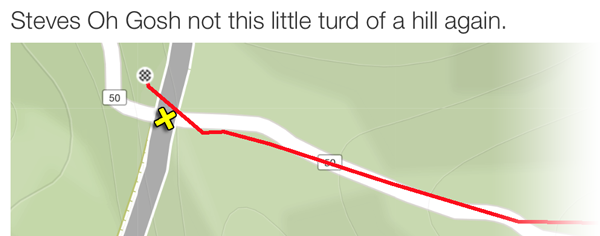
The high point on this climb is the pass marked with a yellow “X” in the screenshot above. The road on either side is quite steep.
Any reasonable segment for this climb should end at or perhaps just a bit before the yellow “X”, but this segment continues down the other side a bit, including an area just below the pass that's a natural rest area (it's the location of the lead photo of this blog post).
So, if you stop to rest at the natural spot after the climb, this segment includes the rest time. It's a useless segment that I certainly hide. (It's also a good example of another bad segment quality... a stupid or selfish name; we'll see more on that later.)
Another kind of ending point has a less-obvious but more insidious problem... here's the end of a segment in San Francisco that runs along a bicycle path for 3km (2mi), named “Great Hwy Sprint North”:
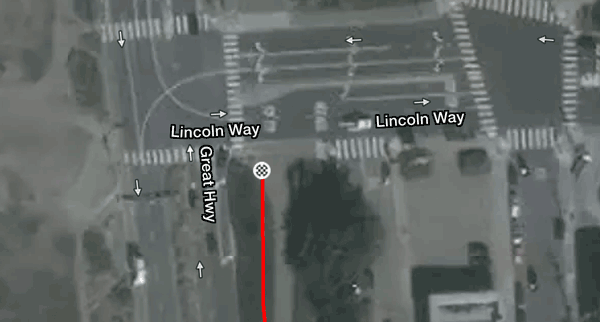
It looks to end about a long car length before the side-to-side sidewalk at a big cross road. It's back enough that those stopping at the sidewalk might not see their stopping time included in the segment, so that perhaps won't be a problem, but geez, considering that those in the run for a KOM need to average 60kph (36mph) over the whole segment, the stopping point doesn't seem to afford space to safely slow down after the segment.
If the segment were to end just before an intersection, a green light would allow the rider to end the segment at full speed and continue through safely, but as it is, one is forced to slow down before the end, which sort of defeats the point of a sprint segment.
I would be dangerous to finish this segment at full speed, but I wouldn't call this segment “dangerous”. A cyclist can be dangerous... actions can be dangerous.... but we're each responsible for our own choices. This segment is merely “poorly constructed”. I would hide it.
If I were to make a replacement segment, I'd have it stop a bit earlier so that one could safely cross the end of the segment at full steam. I'd try to find some real-world feature to end the segment at so that the end spot would be easy to remember. Google's Streetview of this area shows some posts at intervals along the path... I'd try to have the segment end at one of them.
Undesirable Trait #3: Bad Road Tracking
The track used by the person creating a segment becomes the master template for the segment against which all other rides through the area, past and future, are matched. The closer to reality a master track is, the better chance that it has to match others' rides properly.
So how well do you think this segment will perform?
This is just ridiculous, and should have never been made into a public segment. Luckily it's so bad that it's only ever matched one other person's ride, so it's not polluting everyone's data, but still.
The one other ride that it matched illustrates a general problem with bad tracking. Due to the crazy track, it matched the other guy's ride starting not at the base of the actual climb, but well into the climb, giving him an artificially short time (and, as it turns out, the KOM) for the segment:
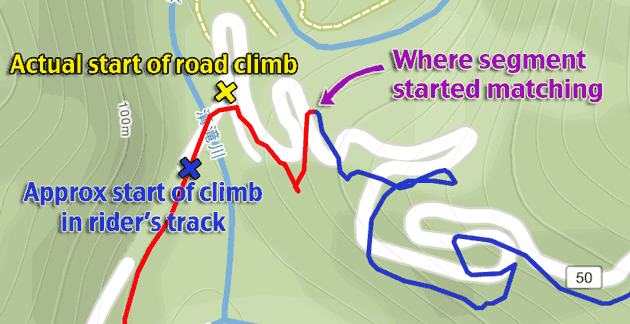
If you think to investigate these details, and know how, you end up discounting this KOM and this entire stupid segment.
I can guess how the segment got created. The guy who created the segment is really fast and has KOMs all around Kyoto. He hit this climb hard, and if his GPS unit had tracked well, he would have been in the running for the KOM. But his GPS tracked so poorly that it didn't match the segment for the climb, so in order to see how fast he'd done, he created a segment from his ride with a best guess as to where the climb actually started and ended in his jumble of a track. It's a fine idea, if he'd kept the segment private.
Before we move on, for reference I'd like to show the segment I made for this climb, with the path hugging the left side of the road that we drive on here in Japan:
I go a bit beyond most Strava users... I use road and elevation data from the government to computer-generate highly-accurate segments like the one above. Sadly, because Strava's policies intended to promote good segments are actually counter-productive in practice, most users will never know this segment exists, instead being shown a variety of less-accurate ones.
Undesirable Trait #4: Bad Summary Statistics
Each segment has summary data that includes the segment length, the vertical climb, and the average gradient.(sort of)
In the segment list seen after a ride, those three items are shown under the segment name. Here's an excerpt from the long Hawaii climb seen at the start of this post:
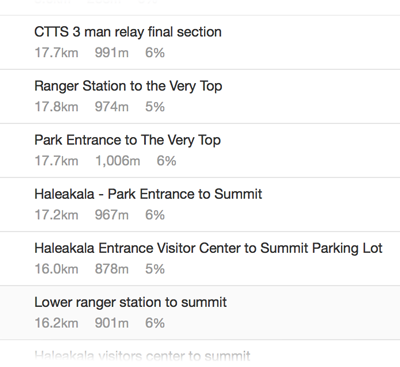
The six segments seen above all more or less cover the same stretch of road, with the minor differences in statistics stemming partially from where exactly each segment creator choose to start and end the segment, but even more, to the fact that each segment is made from a specific ride's GPS track, and that the quality of GPS tracks can vary widely, especially with respect to elevation (which, as we know, Strava has “issues” with to begin with).
This long Hawaii climb is on a road that offers a clear view of the sky where GPS units tend to perform well, so there's little variation among the segments seen above, but in the wider Strava universe, segment summary data can be wildly off. Let's look at some examples from where I ride in Kyoto:
Kyoto has some ridiculously-steep roads, including some with sections that truly are at 25%, but this little segment at the start of the northern ascent to Kyomi Pass is not one of them. In reality, that section of the road rises at 3.8%.
If you're familiar with the area you know that there are no 25% climbs around there, but if this kind of crazy-wrong data shows up in a friend's activity in an area you're not familiar with, it's instinctive to take it at face value:

Seductive
but wrong
Because human nature is so strong to take this data at face value, I think it's important to get rid of incorrect segments like these. I certainly hide this segment.
Here's an even worse example, a flat section of road (should be 0.0%) presented as a grueling 24% climb:
This short segment also goes through three major intersections with long traffic lights, making it inappropriate on an entirely different level as well.
Sadly, segments with this kind of wildly-incorrect stats abound. Our only recourse to make things better when we notice them is to hide them.
So, the average grade for a segment is correct if the source ride's GPS data is accurate, but Strava shows us that “correct” doesn't always mean “useful”. Because of how Strava chooses to display things, the average grade is meaningful only if the segment is all uphill or all downhill. If the ride undulates or otherwise goes both up and down, the “average grade” number Strava presents is essentially meaningless from a cyclist point of view.
Consider this segment that climbs at 9% up to the top of a mountain pass, and then much of the way down the other side. To do well on this segment, you must have strength in both climbing and descending:
Strava displays an essentially-meaningless “1% average grade” for this. They look at the difference between the starting and ending elevations, and divide that into the total distance. This is a mathematically valid way to compute something that a mathematician could call “average grade”, but that's about the best I can say for it.
As for usefulness, it's worse than nothing when it comes to informing a cyclist about what to expect on the ride.
The insidiousness is that when this “1%” shows up in a list of segments, those not already familiar with the road will dismiss it as flat. This kind of data falls into “Strava's core reason for existing”, so it boggles my mind that they are satisfied with this as the status quo.
A better solution is a matter of opinion, but the most obvious idea is to divide the total elevation gain (the aggregate of all climbs within the segment, as opposed to the simple difference between start and end) over the total distance. This would be much better for segments that are predominately climbs or descents, but it still fails to accurately describe the effort needed for mixed segments like our example above, for which this method would yield a paltry “3.5%”.
For segments with a non-trivial mix of both ascent and descent, perhaps show the average gain for ascending road, along with a parenthetical note about the average loss for descending road. In this case it would be “5.8km @ 9% (+8.4km @ -4%)”, which much-more accurately describes the effort required for this segment.
Strava doesn't do it this way perhaps because they disagree on its benefit, but more likely both because Strava is challenged when it comes to elevation calculations, and because they consistently show a willingness to abandon what should be one of their core competencies.
Undesirable Trait #5: Stupid or Selfish Name
When you create a segment in Strava, you have the option to keep it private to yourself, in which case the name matters only to you. But normal public segments are a shared resource for all Strava uses, so unless you're selfish and inconsiderate, they should be created to be a shared benefit.
A name like that seen above, “Steves Oh Gosh not this little turd of a hill again.”, is a remarkably meaningless name. The guy who created it (“Steve”, one supposes) couldn't even be bothered to punctuate properly.
Another example from Kyoto, probably from the same guy, is this even more-meaningless name: “Steve's Monkey T Sprint KYOTO”. The name tells us that it's a sprint of some sort somewhere in Kyoto, but otherwise nothing. I'm sure the name is an inside joke of some sort, so it'd be a great name for “Steve” to have as a private segment, but there's no meaning for others. I hide it.
There are a bunch of rides around Kyoto with names that start with “Steve”, so perhaps he attempted to create a “brand” of segments that all share a certain something? I don't know, but all I came across shared a stunning lack of quality, so I quickly learned to hide them any time I came across them.
Unfortunately, there are no end to stupid, meaningless segment names on Strava. A quick perusal yields such gems as:
- Sprint for your life!
- Dog Eat Dog
- stupid
- too good to delete-
- ❤️Chase me Chase me❤️
- Thank God
- annoying hill
- Better Version
- happy
- Tailwind? Nah! just your wishful thinking
- mydailyroutine-fixed
- Xyzzy
Seriously? These are just moronic.
Some names are neither stupid nor selfish, but unfortunately lacking nevertheless. If you can approach a mountain pass from both sides, a name like “Bigmountain Pass Climb” doesn't tell you which of the two sides it refers to.
I think segment names should have logical, boring names that actually describe the segment, letting the nature of the ride itself lend fun and excitement instead of trying to force it via a “witty” name.
So, that's how I name segments that I create. For example, there's a mountain pass in Kyoto named “Ebumi Pass”, and if you approach it from the west, you'll find segment “Ebumi West”, and if you then go down the other side, “Ebumi East Descent”.
If you then turn around to retrace your steps, you'll traverse “Ebumi East” and then “Ebumi West Descent”.
Boring, yes, but also clear, understandable, and unambiguous in the local context.
Actually, those are just the English parts of the names, which actually also include a Japanese version as well. This part of the global shared resource — road segments — is in Japan, so if one has the linguistic ability, it's only considerate to include a Japanese version in the name.
So, my “Ebumi East” segment becomes “江文東 / Ebumi East”, which is a bit noisy, but still reasonable, and useful for both Japanese and English-speaking foreigners alike. English is the lingua franca among non-Japanese speakers in Japan, so an English version of the name has wide utility.
I sometimes see groups of segments with a commonness to the names that implies a kind of “branding”, such as the “Steve” segments seen earlier. I think for the most part this is merely ego and selfishness, but I do see one rationale for branding: to advertise a certain level of quality. After a few paragraphs I'll explain how I utilize segment-name branding this way, but first a bit of background on why this comes about...
When creating a segment on Strava, you have only one way to communicate to others everything you want to say about the segment: the title. It'd be nice if Strava added a “description” field, “Author/Creator” field, a name-in-another-language field, and such, but they don't. This is really unfortunate because there are a lot of things you might want to tell others when creating a segment, not the least of which is why this segment is better than whatever segment it's trying to replace. So if it's important enough, you have to communicate it in the title.
Searching Strava for segment titles with “fixed” in them shows plenty. (I looked at one, and found it to be just as bad as the original in that it starts just before a big intersection instead of just after, going to show that you just can't blindly trust a segment just because it has “fixed” in the title.)
I sometimes go through quite a bit of work to create super-accurate segments in Japan, applying my computer-science geekiness to computer generate silky-smooth segments from highly-detailed road and elevation data from the Government of Japan. These segments go so far as to follow the left edge of the road (Japan drives on the left side), and they have an elevation profile that's faithful to reality. I would suppose I'm the only one in the world crazy enough to put this much work into it.
Anyway, I'd like to communicate the accurate nature of these segments to other users, and the only way Strava allows for is in the name, so I “brand” these segments by adding “Surveyed” (in English and Japanese) to the end of the title.
So now my “Ebumi East” segment name becomes “江文東 / Ebumi East [計測 /Surveyed]”, which is an ugly mouthfull making a ride's segment list look “busy”. I don't like it, and I can imagine some folks might consider this in the “stupid name” basket, but I can't think of any other way to communicate the trustworthiness of the segment.
I tried prefixing the title with a symbol that might communicate what I want, such as “⚒”. This would create a less-cluttered name like “⚒ 江文東 / Ebumi East”, but I had to abandon the idea because Strava's Android app doesn't display this correctly.
So, for the moment I'm stuck with the ugly-but-informative “Surveyed” pattern.
Undesirable Trait #6: Unremarkable or Inconsequential Length of Road
Some segments may be technically fine, but just make no sense in local context. As an example, let's revisit the odd-starting point segment seen earlier. Here's its elevation profile in the local context:
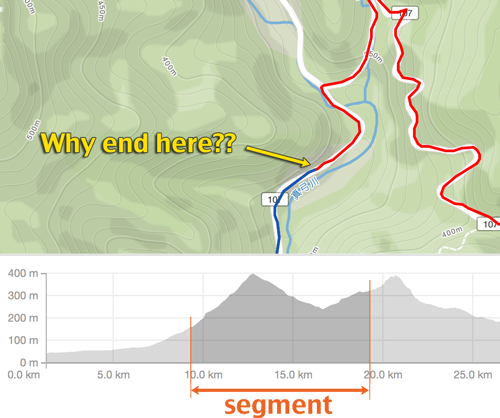
We talked earlier about the slightly-odd starting point, but the ending point sits squarely in the “bizarre” category, just abruptly ending in the middle of the climb up to a pass. Having ridden these roads many times, I just can't see the meaning of a segment that incorporates the climb up and down the one pass, then part way up to the next.
To further boast the “totally clueless” nature of this segment, its name is “府道31号線 Climb full”, which translates as “Prefectural Route #31 Climb full”. The thing is, this name is a fail on all fronts: It's not anywhere close to the full length of Prefectural Route #31, and as a bonus, ¼ of the segment is on a different road entirely. It's not a full climb either, nor even really “a climb” at all since almost half is a descent.
So why does this segment even exist? I can think of three reasons:
- There are community benefits that I'm just not seeing.
- The person who made it was sloppy and inept.
- Unlikely, but perhaps a person didn't make it at all; perhaps it was automatically made by Strava.
That last possibility brings up the topic of auto-generated segments...
Strava-Generated SegmentsBack when Strava was young and there weren't many segments yet, in an effort to seed the pool, so to speak, their computer would analyze an activity and automatically generate segments for climbs that didn't otherwise have segments yet. This hasn't been done for a couple of years now, but those auto-created segments remain. These auto-created segments always got titled “road name Climb”.
These are easy to spot here in Japan because the “road name” part is in Japanese and “Climb” is in English, for example “府道31号線 Climb”, a climb on Prefectural Route 31. Going back to the start of this post, this is probably the origin of the four “Haleakala Highway Climb” segments along random parts of the road.
Because these automatic segments are based upon a user's GPS track, they're ultimately subject to the accuracy of the recording device's elevation data, which even today can be wildly inaccurate. When it works well you end up with a nice segment from the bottom of a climb to the top, but more often you get little tidbits in the middle of a climb where the user's elevation recording happened to fluctuate.
For example, a few years ago some guy rode up this beautiful, smooth climb. It's a proper climb that just keeps going up, with no flat or downward sections, but as is common with GPS devices, his device recorded quite a bit of fluctuation during his ascent that simply wasn't there:
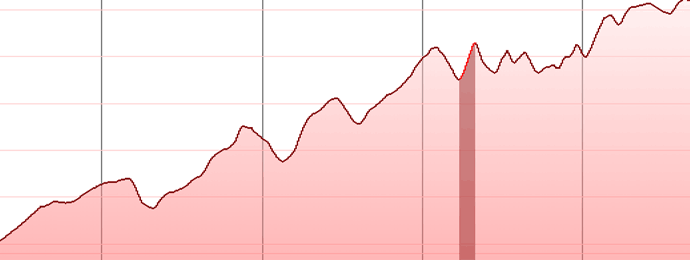
Among the various bumps, Strava for some reason chose to make the marked part into a segment, with (of course) a “... Climb” title:
So, these “road name Climb” segments are often junk. I tend to hide them.
Undesirable Trait #7: Inappropriate for Strava's Matching Algorithms
Sometimes a segment has all the hallmarks of quality, but just doesn't work well with Strava's track-matching algorithm. A simple example is this climb on an old road now bypassed by a long, dark tunnel going almost directly underneath:
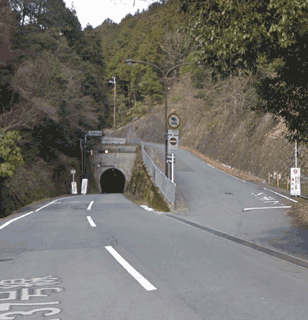
Start of the climb
the climb rises at right, then crosses over the tunnel |
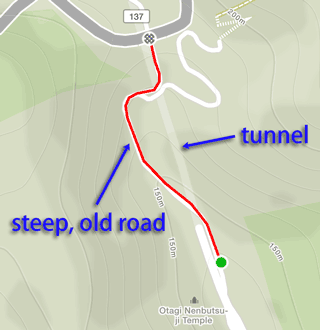
Segment ends directly over tunnel
(confusingly, itself directly under a parkway overpass) |
The track for a rider going through the tunnel also appears to go through the start and end of this climb, so Strava can't tell the difference, so this segment gets matched:
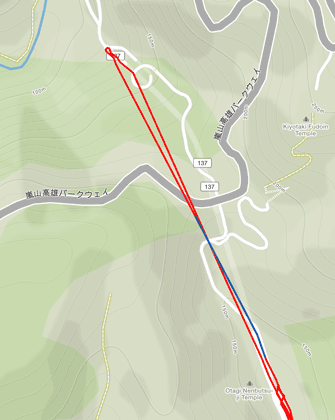
Improper Match
through the tunnel both ways |
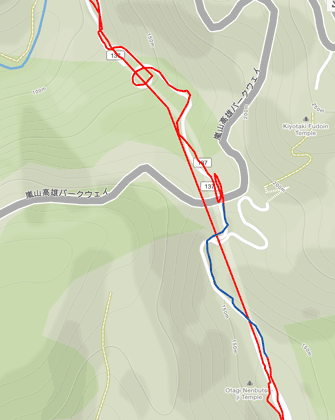
Proper Match
north over the climb, south through the tunnel |
That “proper match” effort is mine and is currently the fastest time for the climb and should be the KOM, but it shows up as #15 on the leaderboard because those above were improperly-matched efforts. Any number of friends could easily beat my time of 1:25, but they'd have a difficult time beating the currently-listed KOM of 31 seconds, unless they also went through the tunnel like that rider.
(By the way, the temple noted at the bottom of the maps above is the same one seen on my blog in “That Kyoto Temple With the Many Whimsical Statues”; it's well worth a visit if you're riding by.)
When two segments more or less overlap, it's difficult to blame Strava for not noticing the difference, but many mismatches are less obvious. Consider the little climb seen in this closeup of the heat-map screenshot seen in the “local considerations” section above:
That little bit of road is the super-steep entrance to the temple seen on my blog seven years ago in “A Visit to Western Kyoto’s Konzou Temple”, where a younger and fatter me visited with my son, via scooter. I did visit again last year via bicycle, but my ride didn't match a segment I made for the 18%-average-grade driveway. Strava's “Potential Segment Matches” page for the ride says:
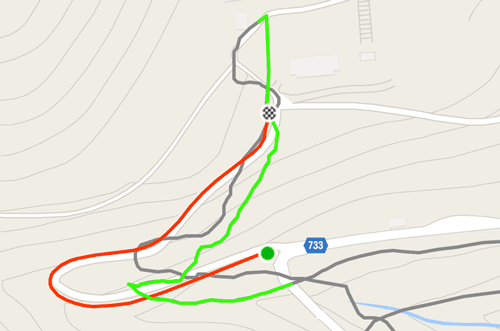
- Your Activity
- Selected Segment
- Partial Segment Match
We could not complete the match.”
I'm not sure what's going on here... my ride's cruddy track somehow matches the segment perfectly right up to the finish... but then inexplicably continues matching for a while. Yet, Strava says it failed just before the halfway mark? I'm left baffled.
Worse, though, is that the next time I rode it, it not only matched the climb segment on the way up as it should have, but also matched the descent as well:
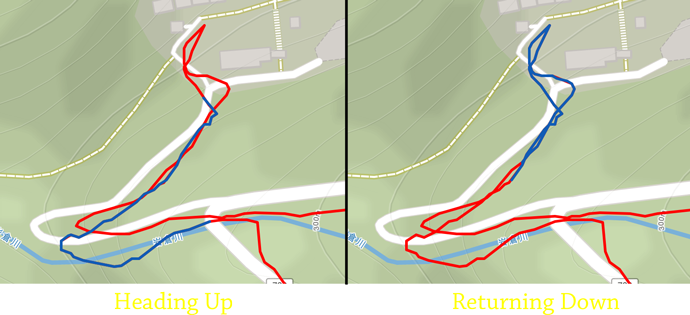
once each way, that matched the segment
In looking at the rides for the top of the leader boards for the segment, it appears this problem is widespread.
The segment just doesn't work well with how Strava matches... the start and end are too close to other parts of the segment, and to each other.
It's a problem common to short segments with non-segment road nearby. I first noticed it with this segment, covered on my blog in “Kyoto’s Nasty 21% City-Bike Hill Climb”. A rider speeding by on a flat road nearby matched this steep climb, “earning” the KOM with a time of 11 seconds:
These kinds of false matches can absolutely destroy the leaderboards, leaving them meaningless. The actual KOM is this 24-second effort by a friend, but it's listed as the 77th overall! (To figure that out, I had to inspect each ride on the leaderboard until I found one that matched properly; FWIW, my personal best is 32 seconds.)
Another example shows a road too twisty at both the start and end for a reliable match of either. Here's the current KOM for that segment:
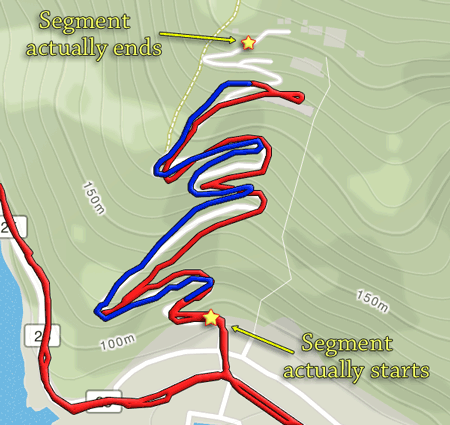
but the segment actually starts and ends at the two yellow “★”
This rider turned around two hairpins short of the full segment, but it was close enough for Strava's matching. Combined with the late match at the start, his overall time is seriously truncated, “earning” him the KOM.
It's not the rider's fault that Strava doesn't match these correctly, and frankly, I don't blame Strava for it either. There's an incredible range of GPS quality levels, but many tracks, especially in mountainous areas, are all over the place, and Strava's algorithms work hard to match as reasonably as they can. If the algorithm has to allow for a track error placing it 100 yards off the road, such a track is indistinguishable from a track on a different road that's actually within that distance. Trying to balance the various considerations involves a level of juggling well beyond my paygrade, but it seems that short segments, which are iffy to begin with (due to the aforementioned GPS quality levels), are where matching most often fails. It seems like a smart balance to me.
Overall, that Strava can do as well as they do, so quickly, with so many segments and activities every day, is only slightly short of magic.
I do blame Strava, however, for not providing a way for a rider to manually remove a segment match from an activity. I think that keeping leaderboards clean falls into the “core competency” of their business, and in this respect they fail. With the “Nasty” example above, I learned that I simply can't ride on that road that gets incorrectly matched if I don't want my own PR leaderboard to be forever polluted with false “PRs”. It's silly to modify my real-world movements to satisfy my data-integrity geekiness, but I do.
Not only do I wish Strava would let us remove an incorrectly-matched segment, but I wish they would let us flag incorrect matches in other riders' activities, to alert the less-savvy Strava user to the situation. These are among my #1 wishlist items for Strava.
So that's that. If you actually read this far, in the time it took to read you probably could have Everested your favorite climb. Hopefully, the time spent was worth it and together we can make the Stravaverse better for all.
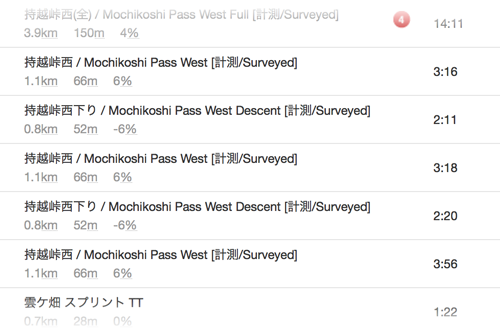
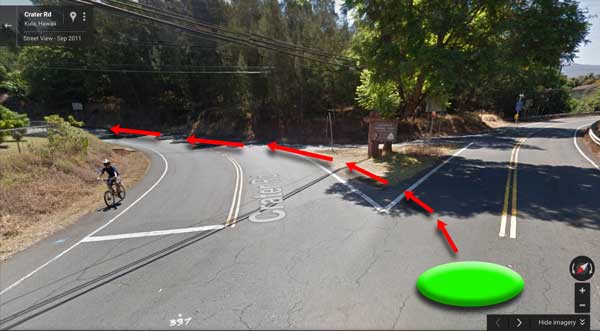
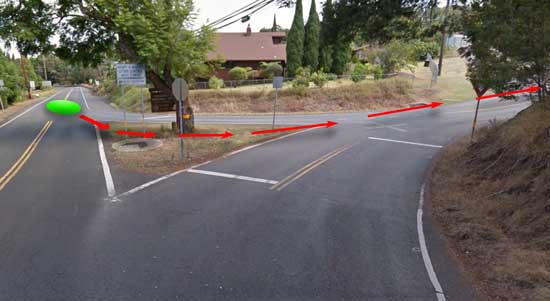
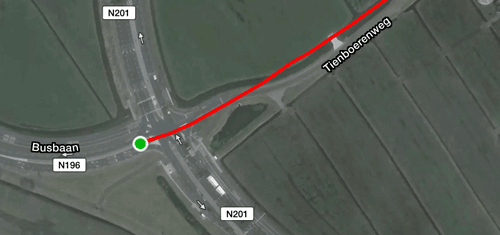
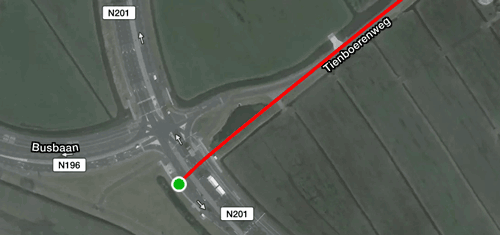
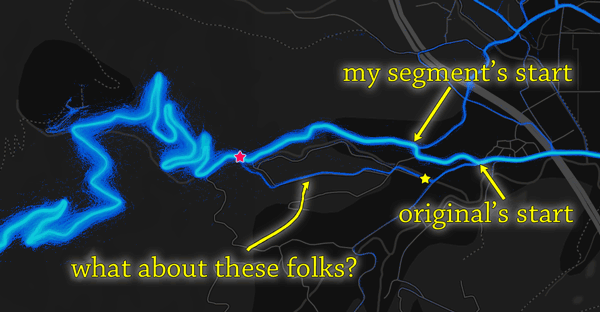
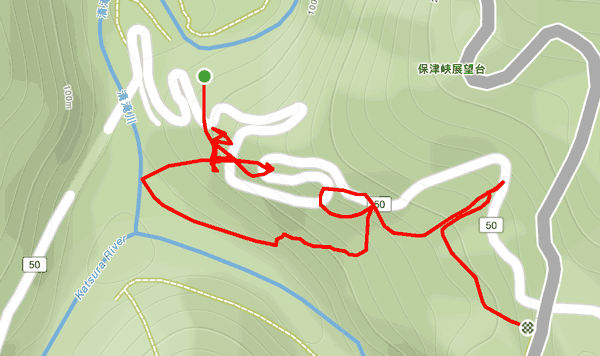
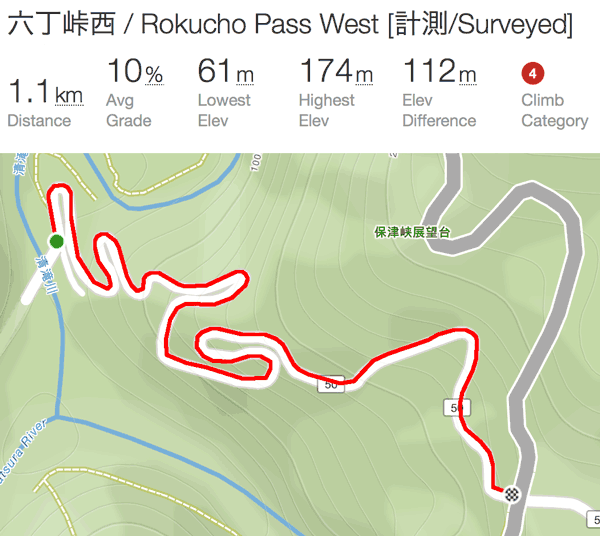
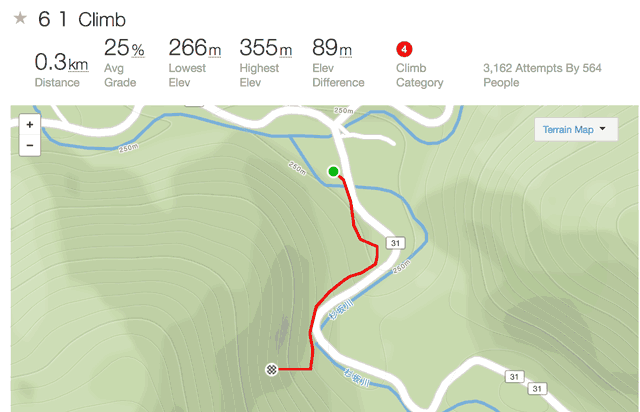
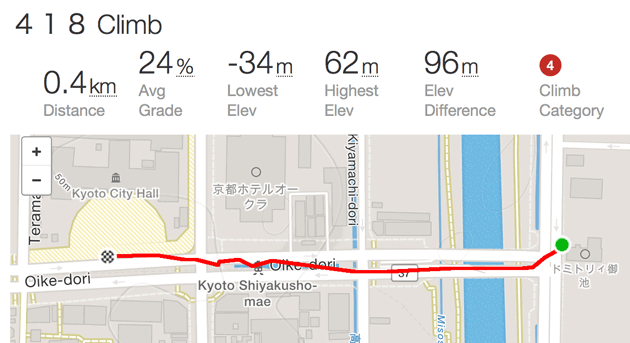
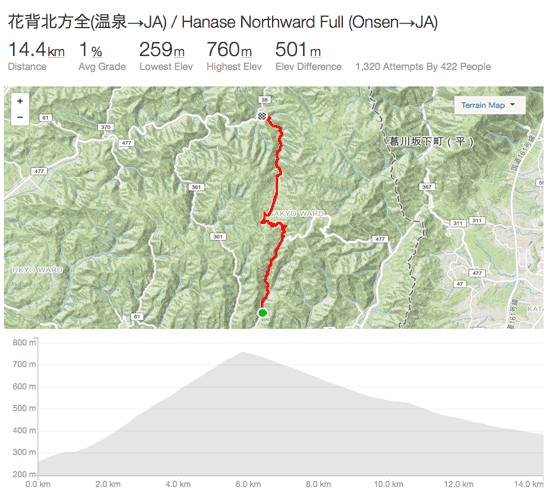
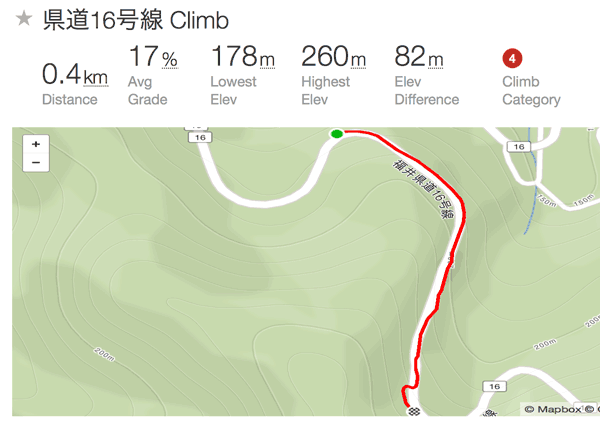
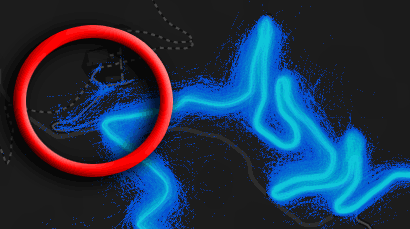
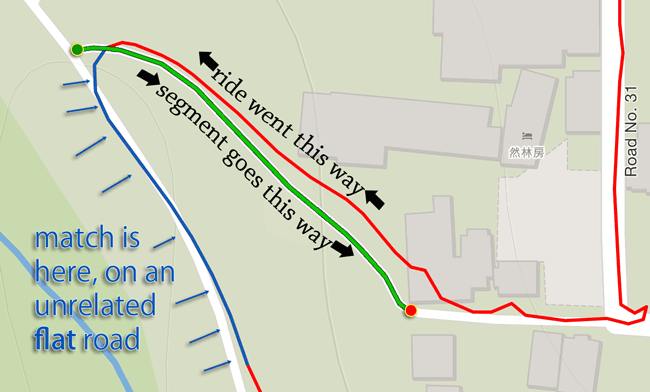
Very interesting post. It was nice to see my hill repeats featured here! The older 持越峠(真弓側) segment is another example of a segment with a bad starting point right at the turnoff. Because I didn’t go past the turnoff point every time, my hill repeats on that day were recorded with rest times included.
Your effort put into the segments you create is greatly appreciated. For the most part, I’ve switched over to your segments whenever I find them. I agree that Strava needs to give users the ability to report suspicious/faulty efforts and add information about segments. Have you seen the recently updated KOM for “Hanase North“? I wonder what is going on there (perhaps the guy got in a car and forgot to turn his phone off)? There is no way that someone could cycle that segment in 15 minutes! Problems like this are evident with many segments (the KOM on “Momoi steep section” looks very suspicious too), and this is frustrating because it pollutes the data even for high quality segments like yours. One other desideratum is for the live Strava segments feature on Garmin to actually work. It’s rare that I get a segment that will show up properly on my Garmin, so if I want live segments I have to record both with my Garmin and with Strava on my iPhone.
About the fast time, why not just put a comment asking him? A pro could do it that fast, I suppose, but this guy was just out on a group ride and seemed slow for everything but that. About Strava Live Segments, they’re a bit disappointing because they just divide the distance over the time, assuming the whole segment is at the same gradient. A segment that has any fluctuation doesn’t work well. )-: —Jeffrey
Wow, this is a terrifically detailed guide, well done for putting it together. It should be compulsory reading for anyone who wants to create a segment on Strava.
I’ve written blog posts in a similar vein, like this one – 7 reasons why some Strava segments suck – do yours?
Keep up the good work 🙂
Alan
Hey Alan, as I looked over your link, it all felt familiar, then I realized that I’d read your article when I was learning about Strava. Thanks for writing it! My article started out with the simple intention of showing folks about hidden segments, then sort of grew into a bigger tutorial. It ended up being a passive-aggressive version of your post, not telling segment creators “here’s why your sucky segments suck”, but instead telling everyone else “here’s how to recognize sucky segments”. More or less the same thing in the end 😉 —Jeffrey
Another phenomenally good blog post – thanks!
However, there’s one key area which I’m surprised you omitted: Strava does actually let you flag segments as inappropriate. Granted, according to the page URL and description, Strava claims they’re only letting you flag segments as “hazardous”, rather than the wider category of inappropriate. However, if you look more closely at the list of available reasons shown in the page linked below which can be provided when flagging a segment, you’ll see that they also support reasons which have nothing to do with safety[0]:
“Vehicular traffic, stop signs, stop lights or busy intersections” could be used to get rid of some segments which have stupid start or end points.
“Bad data or duplicate segment” could be used to flag segments with inaccurate GPS data.
“Inappropriate or improper name” could be used to flag segments with moronic or unhelpful names.
“Other” is a delightful catch-all reason.
Finally, there’s even a freeform text area where you can provide additional detail! (This begs the question, do they have a dedicated team reviewing flaggings? Presumably they must.) So the situation appears to be far better than your blog post currently describes. Of course, how well this works in practice remains to be seen, so I’m now going to test it out by flagging a segment with a stupid name …
Oh, wow. Just WOW. How stupid can Strava actually get? I checked the “Inappropriate or improper name” option, filled in an explanation of why the name sucked, submitted, and got this:
You have chosen to flag this segment for: “Bad name”. Unfortunately, segment flags are reserved for hazardous segments only.
The best way to receive assistance about this type of issue is to contact our Support team. You can forward the details you provided to Support by clicking “Contact Support” below.
Just unbelievable. What kind of moron would come up with a UI which invites you to contribute something and then chucks it back in your face?
[0] I guess they started off by only supporting flagging of hazardous segments, and then some sloppy software engineer added other options without even bothering to update the text.
Yeah, as I was reading the first part of your comment, I was thinking I’d have to go back and test that again… glad you did it for me in the latter part of your comment. :-). The idea of prompting for an option you’re not going to handle actually seems sound to me, to catch those and direct them appropriately so that they don’t end up getting squeezed into the wrong path. The problem here is deeper in that they simply won’t deal with important things they should, and then spit that back in your face. —Jeffrey
Another great post, and in this case one of deep interest to all of us who use Strava. It was well worth the read. Thank you for your principled, detailed and tireless efforts to make the Stravaverse a better place. When you write a post like this, do you alert anyone at Strava and encourage them to read it? It goes without saying that the more feedback like this they get, the more likely they are to try to improve their segments system.
I know that an engineer acquaintance at Strava has read it. It’s clear from the site, though, that this kind of quality is just not a priority for them as a business, despite how each employee may personally feel. They show this in so many little ways. For example, if I upload a “ride” that averages more than 100mph for hours on end, you might suspect that I didn’t actually ride a bicycle, but they allow such activities to upload and pollute the leaderboards. Here’s an example of more than a dozen segments polluted via a train and car ride. Worse yet is that these bogus activities pollute any segment that might ever be made anywhere along the route. I don’t know where I’d draw the line, but as a first stab anything that averages more than 100mph for more than five minutes might garner a “are you sure?” interstitial when uploaded. Having worked for a popular customer-facing web site in the past, the only plausible reason I can imagine for them to not spend just a little of their scant resources on this kind of issue is that they just don’t care (as a business). I’m a great example of why they don’t have to care… I care very much about these issues, they still don’t fix them, and I’m still giving them money every month. Sigh. They have critical mass, and like the only restaurant in a middle-of-nowhere town, they just don’t need to worry about the quality of the food. —Jeffrey